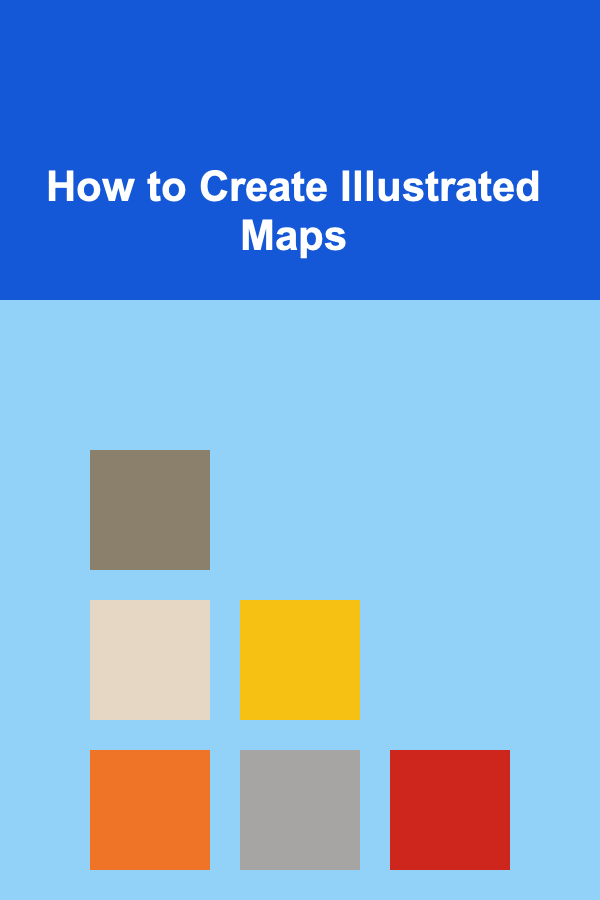
How to Create Illustrated Maps
ebook include PDF & Audio bundle (Micro Guide)
$12.99$5.99
Limited Time Offer! Order within the next:

Creating illustrated maps is an art form that blends creativity with geographic knowledge. These maps are not merely tools for navigation; they are visual stories that guide viewers through a place in a unique, engaging way. Whether for travel guides, fantasy novels, or personal projects, illustrated maps offer a way to showcase locations in a way that traditional maps cannot.
This article will take you through the process of creating illustrated maps, from the initial planning stages to the final touches. We'll explore various aspects, including understanding the purpose of your map, gathering the necessary materials and tools, techniques for drawing and coloring, and tips for adding the artistic elements that make an illustrated map stand out.
Understanding the Purpose of Your Illustrated Map
Before you pick up your pencil or stylus, it's essential to understand the purpose of your map. The style and design will vary depending on whether the map is meant to inform, entertain, or showcase artistic flair. Here are a few questions to help you define your map's purpose:
- Who is the map for? Are you creating it for tourists, fans of a book, or for personal use? Knowing your audience helps shape the map's style and complexity.
- What is the primary goal? Do you want the map to provide specific information (such as a hiking trail), convey a sense of place (like a fictional world), or simply look beautiful?
- What features should be included? Think about what landmarks, roads, rivers, or regions are essential. You may want to include cultural or historical markers depending on the map's purpose.
Once you have a clear understanding of the map's function, you can start planning the layout and artistic direction.
Gathering Materials and Tools
Creating illustrated maps requires a combination of traditional and digital tools, depending on your preferred method. Here's an overview of the materials and tools you might need.
Traditional Tools
- Pencils and Erasers: For sketching the initial design, a good-quality pencil is essential. It allows for flexibility in refining the map before committing to ink or color.
- Inking Pens: Once you're happy with the sketch, inking pens help define the lines and make the map visually striking. Fine liners with varying thicknesses are excellent for adding details.
- Watercolor or Markers: If you're working traditionally, watercolor paints can add beautiful texture and color to your map. Alternatively, markers or colored pencils provide vibrant, solid hues.
- Paper: Choose high-quality paper for your final artwork. Watercolor paper is ideal for washes, but for simple sketches, a smoother drawing paper can work fine.
Digital Tools
- Drawing Tablets: A graphic tablet or a stylus for drawing on a computer gives you precision and flexibility in your artwork. Popular tools include the Wacom series or iPad with Procreate.
- Illustration Software: Adobe Illustrator, Photoshop, or Affinity Designer are excellent programs for creating detailed and scalable illustrations. These programs provide access to various brushes, textures, and color palettes.
- Reference Images: If you're creating a map based on a real location, gather photos and maps for reference. For fantasy maps, consider collecting inspirational images of landscapes, architecture, and other features.
Drawing the Base Map
The base map is the skeleton of your illustration. It's where the most crucial geographical features are placed. Whether you're mapping a real-world location or a fictional one, these steps will guide you through the process.
Step 1: Research and Plan
For real-world maps, research is essential. Study the topography of the area you want to map. Look at existing maps to understand the geographic relationships of locations. For fictional maps, create a mental or physical list of key places and their relationships, such as cities, landmarks, and natural features like mountains, rivers, or forests.
Sketch a rough outline of your map's area, keeping in mind where these features will be placed. Consider the scale: Will it be a small, zoomed-in area like a city, or a large region, such as a continent or a country?
Step 2: Sketching the Main Features
With the rough plan in mind, begin sketching the key features of the map. If you're working on a real-world location, focus on the most significant landmarks, such as rivers, mountain ranges, and cities. If it's a fictional place, begin by outlining the terrain and main features you've imagined.
Start by lightly sketching with a pencil so that you can adjust as necessary. Focus on basic shapes and placements---don't worry about the details yet.
Step 3: Adding Roads and Smaller Features
Once the major features are in place, add roads, trails, or other smaller features, depending on the map's purpose. For a city map, you might add streets and alleyways. For a fantasy map, perhaps paths or magical locations.
If you're mapping a terrain, consider how different features interconnect. A river might wind through the landscape, or roads could connect towns and cities. Place these in logical positions, taking note of the geography and intended flow.
Step 4: Refining Your Sketch
With all the primary and secondary features in place, refine your sketch by cleaning up any unnecessary lines. Add more detail to the features, making sure to keep the visual hierarchy intact. Larger, more important landmarks should stand out, while smaller features can be subtle.
Step 5: Inking the Design
Once the sketch is ready, begin inking over the lines you want to keep. Use a variety of pen thicknesses for different features: bold, thick lines for major elements like borders, roads, or rivers, and finer lines for small details like trees or buildings.
Inking is the most important part of giving your illustrated map definition and structure. Be patient and deliberate with your lines. The inking process will make your map more readable, professional, and visually striking.
Adding Color and Texture
Now comes the fun part---adding color! The color palette you choose should be in harmony with the theme of your map. Real-world maps tend to use muted tones to reflect natural colors, while fantasy maps may feature more vibrant, whimsical hues.
Step 1: Choose a Color Scheme
For real-world maps, it's best to stick to natural color palettes. For instance, use greens and browns for forests, yellows and tans for deserts, and blues for water features. In fantasy maps, you have more freedom to play with unusual color schemes, adding an imaginative touch to your work.
The colors should complement one another, so choose a scheme that doesn't overwhelm the map but adds clarity. Light backgrounds with contrasting colors for key features can help the map stand out.
Step 2: Add Shading and Texture
Shading adds depth and dimension to your map. Use gentle gradients for areas like mountains or hills to give them a three-dimensional appearance. You can also add texture to forests, fields, or water to make them visually interesting. For example, add cross-hatching or stippling to represent rocky terrain or dense vegetation.
You can create texture either by hand (with traditional techniques) or digitally (with brushes or textures in Illustrator or Photoshop). Layering different textures can give your map a rich, complex feel.
Step 3: Add Final Details
Now, it's time to add the finishing touches. This can include:
- Legend and Labels: Clearly label the places, roads, and other key features of the map. Use an easy-to-read font for the labels, and add a key or legend if necessary.
- Decorative Elements: Add artistic flourishes, such as a compass rose, a border, or decorative icons representing key landmarks (e.g., castles, ships, or animals).
- Watermark or Signature: Some mapmakers like to include a subtle watermark or their signature to personalize their work.
Step 4: Final Adjustments
After adding all the details, step back and assess the map. Ensure the balance between clarity and artistic elements. Are the important features easy to find? Does the map communicate its purpose clearly? If something feels off, don't hesitate to make adjustments.
For digital maps, you can make these changes easily by adjusting layers or colors. For traditional maps, you may need to erase and redo certain parts.
Tips for Enhancing Your Illustrated Maps
Creating a beautiful and functional illustrated map takes practice, but with time, you'll develop a style that works for you. Here are some advanced tips to improve your map-making skills:
- Use Layering: In digital programs like Illustrator, layers allow you to work on different parts of the map separately. This can help you refine your map in stages.
- Incorporate Local Art Styles: If you're mapping a real-world location, consider incorporating local art styles into your map. This can add cultural richness to your design.
- Focus on Iconography: Create unique symbols for specific landmarks or places. Custom icons can give your map a distinctive look and make it easier to interpret.
- Play with Perspective: Try illustrating your map in a different perspective, such as isometric or aerial views, to make it more dynamic and engaging.
- Experiment with Media: Mix different media, such as watercolor with ink or digital painting with vector design, to create a more layered, sophisticated map.
Conclusion
Creating illustrated maps is a rewarding and highly creative process that combines artistic skills with geographic knowledge. Whether you're designing a map for a novel, a tourist guide, or just for fun, the key is to understand your map's purpose and approach it with a clear vision.
With patience, practice, and attention to detail, anyone can create a beautifully illustrated map that captures the essence of a place and takes viewers on a visual journey. Whether you work traditionally with pencils and paints or use digital tools to enhance your artwork, the process of creating a map can be a deeply satisfying way to express your creativity and tell a compelling story.

How to Choose Between Renting Furnished vs. Unfurnished Properties
Read More
How To Master Color Correcting for Different Concerns
Read More
Risk Manager's Guide to Financial Stability: Strategies and Practices
Read More
How To Understand Color Theory in Photography
Read More
How to Find Affordable Flights to Historical Cities
Read MoreHow to Categorize Professional Development Expenses for Optimal Tracking
Read MoreOther Products

How to Choose Between Renting Furnished vs. Unfurnished Properties
Read More
How To Master Color Correcting for Different Concerns
Read More
Risk Manager's Guide to Financial Stability: Strategies and Practices
Read More
How To Understand Color Theory in Photography
Read More